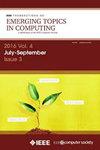无边GNN:无边节点的无监督表示学习
IF 5.1
2区 计算机科学
Q1 COMPUTER SCIENCE, INFORMATION SYSTEMS
IEEE Transactions on Emerging Topics in Computing
Pub Date : 2023-07-11
DOI:10.1109/TETC.2023.3292240
引用次数: 0
摘要
我们研究了嵌入无边缘节点的问题,例如新进入底层网络的用户,同时使用广泛研究的图神经网络(GNN)进行图的有效表示学习。我们的研究是基于这样一个事实,即GNN不能直接用于我们的问题,因为消息传递到这种没有连接的无边缘节点是不可能的。为了应对这一挑战,我们提出了无边GNN,这是一种新的归纳框架,使GNN能够通过无监督学习生成节点嵌入,即使是无边节点。具体来说,我们首先基于节点属性的相似性构建一个代理图,作为底层网络定义的GNN计算图。已知的网络结构用于训练模型参数,而拓扑感知损失函数是以这样一种方式建立的,即我们的模型通过编码节点之间的正、负和二阶关系来明智地学习网络结构。对于无边节点,我们通过扩展计算图来归纳推断嵌入。通过评估各种下游机器学习任务的性能,我们从经验上证明,无边GNN表现出(a)对于无边节点而言,优于最先进的归纳网络嵌入方法,(b)我们的拓扑感知损失函数的有效性,(c)对不完全节点属性的鲁棒性,以及(d)随图大小的线性缩放。本文章由计算机程序翻译,如有差异,请以英文原文为准。
Edgeless-GNN: Unsupervised Representation Learning for Edgeless Nodes
We study the problem of embedding
edgeless
nodes such as users who newly enter the underlying network, while using graph neural networks (GNNs) widely studied for effective representation learning of graphs. Our study is motivated by the fact that GNNs cannot be straightforwardly adopted for our problem since message passing to such edgeless nodes having no connections is impossible. To tackle this challenge, we propose
$\mathsf{Edgeless-GNN}$ $\mathsf{Edgeless-GNN}$
求助全文
通过发布文献求助,成功后即可免费获取论文全文。
去求助
来源期刊

IEEE Transactions on Emerging Topics in Computing
Computer Science-Computer Science (miscellaneous)
CiteScore
12.10
自引率
5.10%
发文量
113
期刊介绍:
IEEE Transactions on Emerging Topics in Computing publishes papers on emerging aspects of computer science, computing technology, and computing applications not currently covered by other IEEE Computer Society Transactions. Some examples of emerging topics in computing include: IT for Green, Synthetic and organic computing structures and systems, Advanced analytics, Social/occupational computing, Location-based/client computer systems, Morphic computer design, Electronic game systems, & Health-care IT.
 求助内容:
求助内容: 应助结果提醒方式:
应助结果提醒方式:


